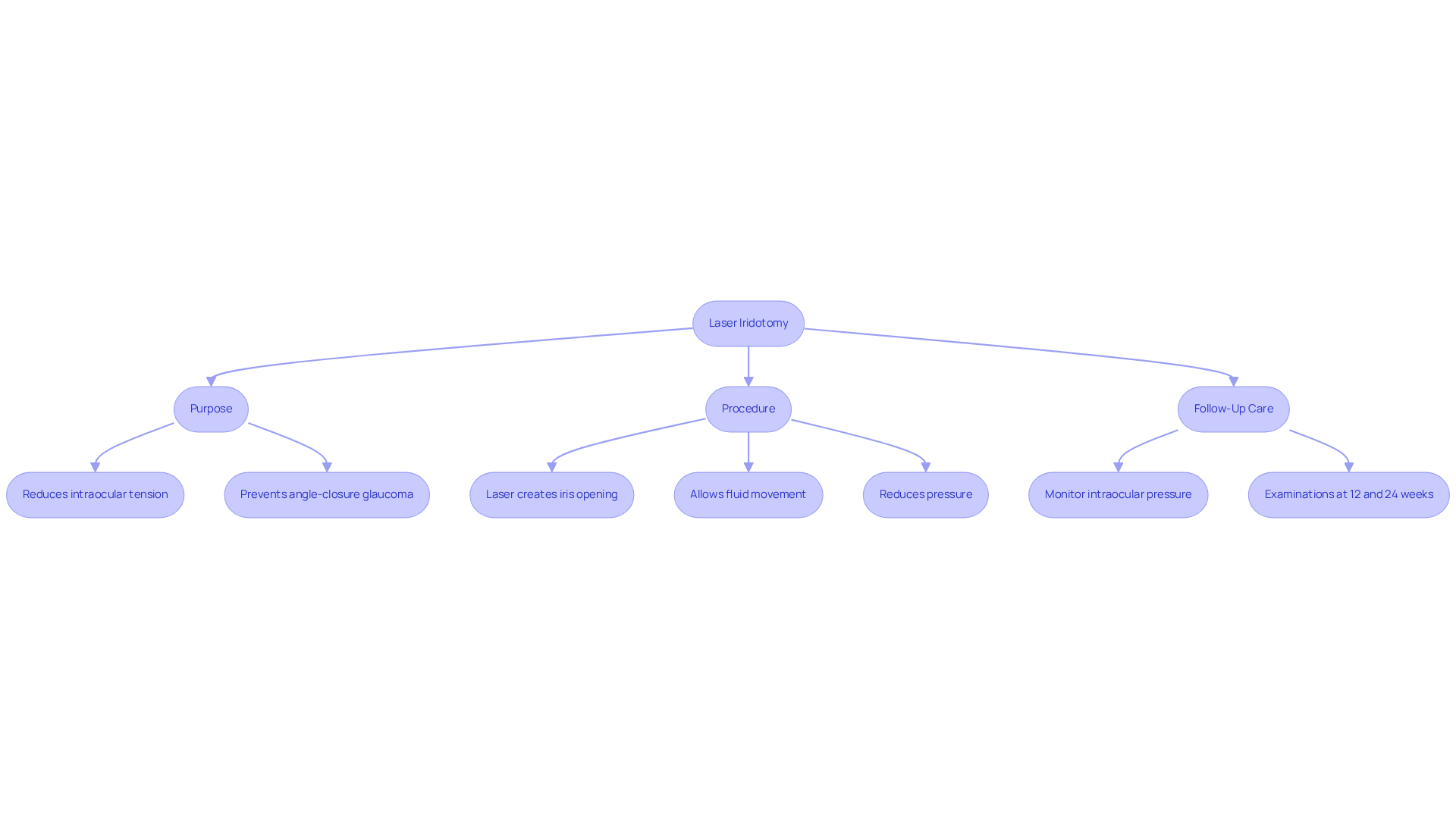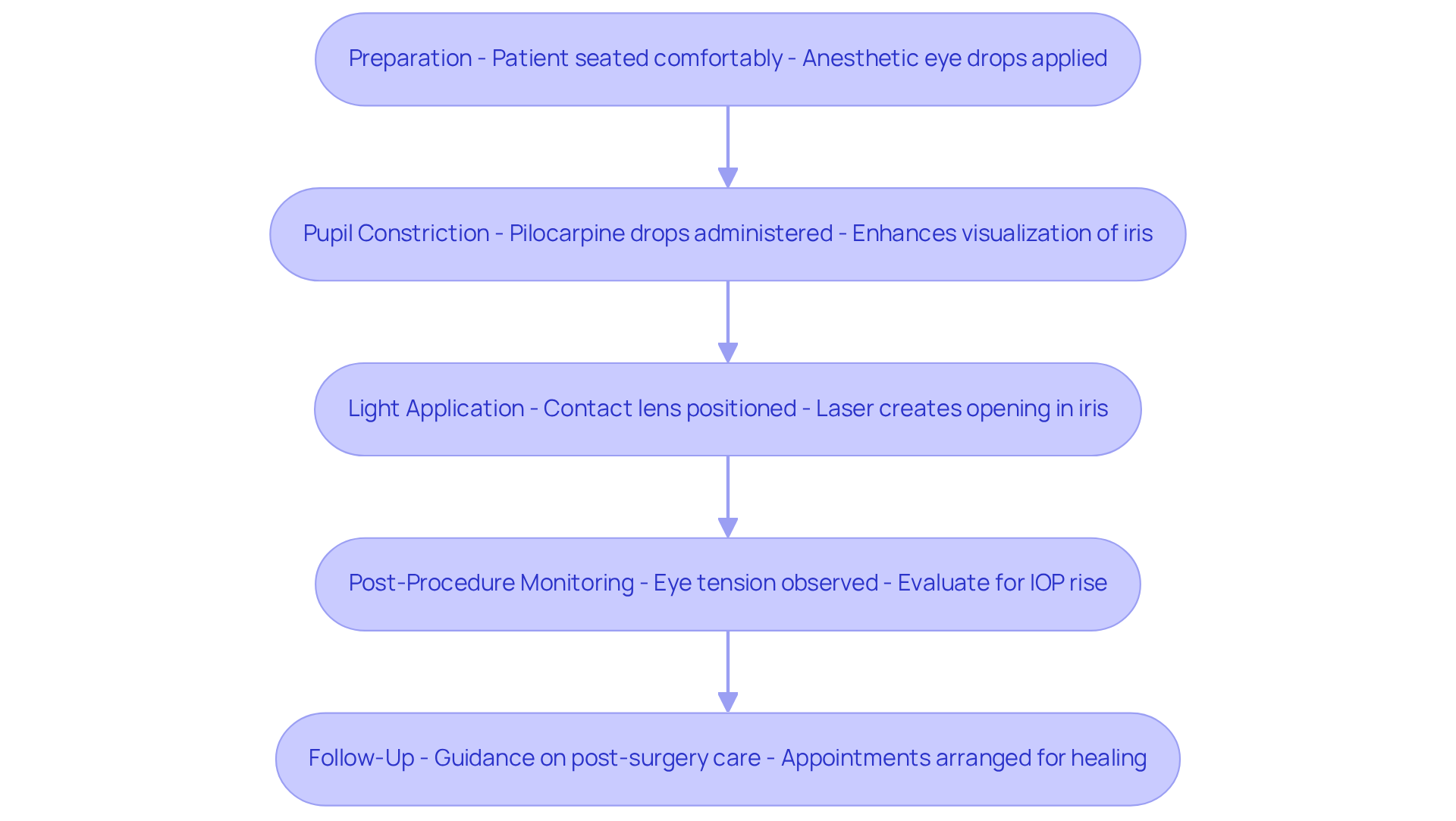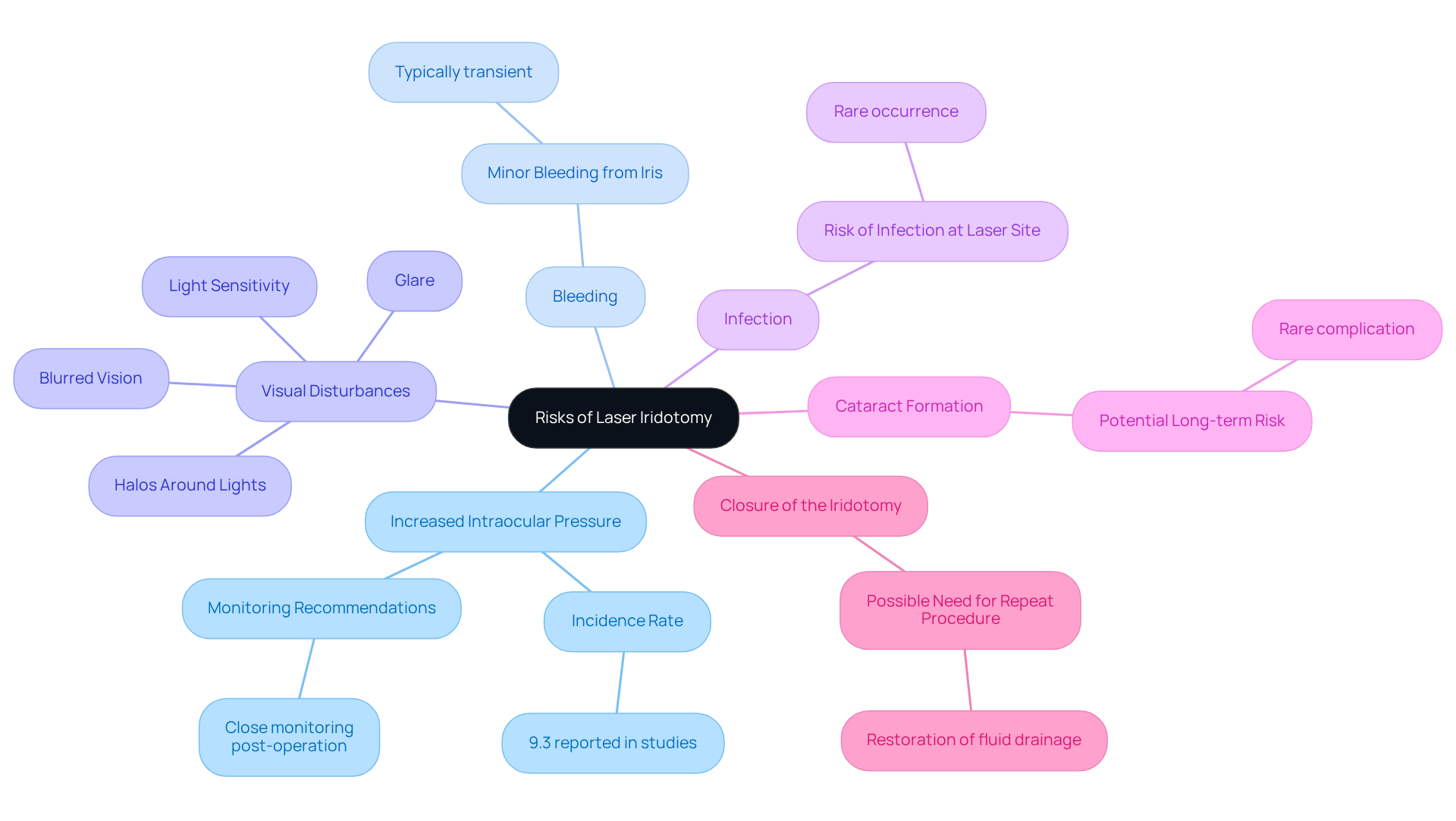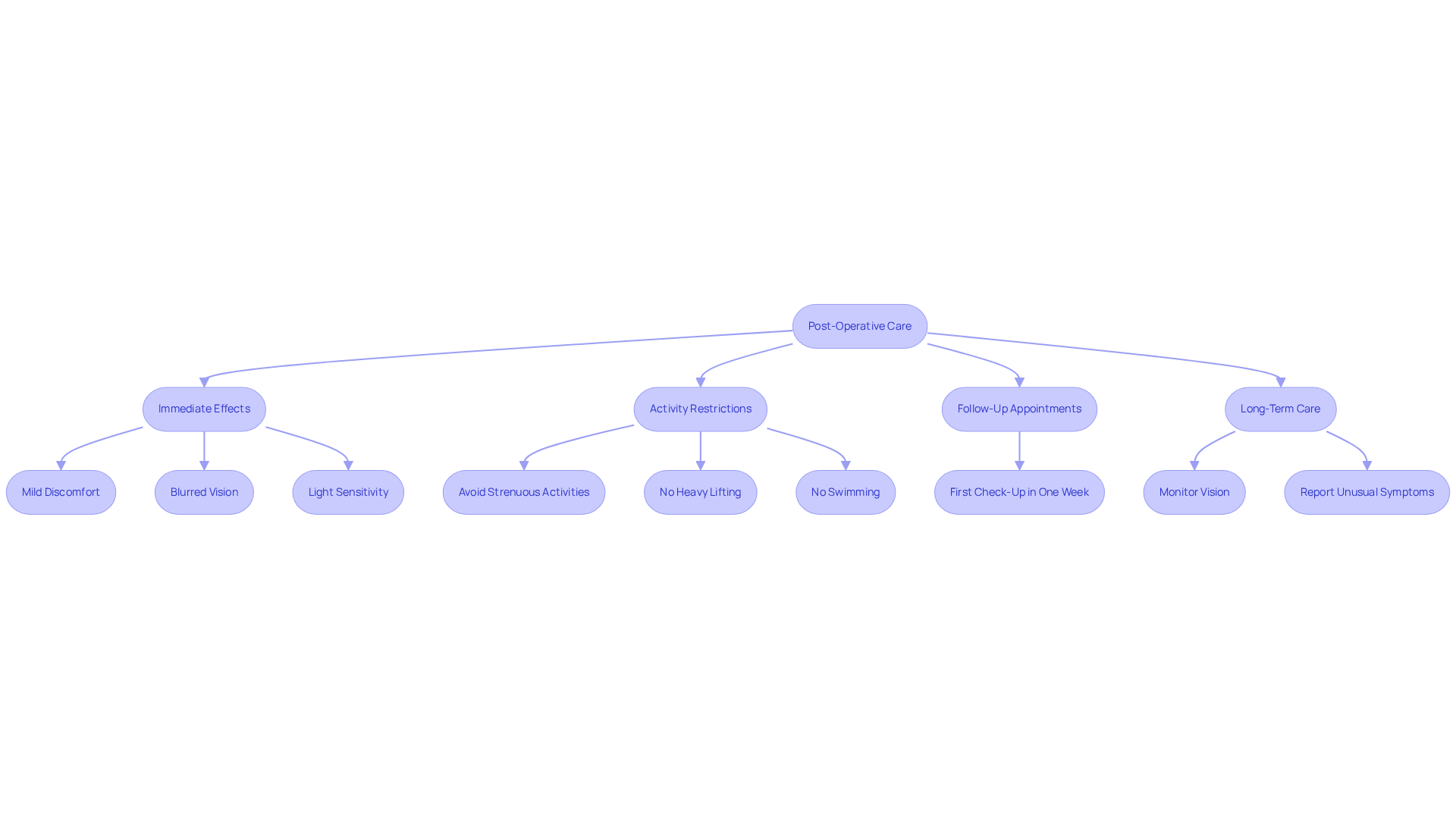Posted by: Northwest Eye in General on August 16, 2025
Overview
Laser iridotomy is a minimally invasive procedure designed to create an opening in the iris. This helps facilitate fluid movement within the eye and reduces intraocular pressure, especially for those at risk for angle-closure glaucoma. We understand that considering a procedure can be daunting, but it’s important to know that this treatment is both safe and effective.
After the procedure, post-operative care is crucial. Monitoring for potential complications ensures optimal recovery. It’s common to feel anxious about what comes next, but you’ll be reassured to know that about 96% of patients do not require further interventions after treatment. We are here to help you through this process and provide the support you need.
Introduction
Laser iridotomy is a significant advancement in managing angle-closure glaucoma, a condition that affects millions worldwide and can lead to serious vision impairment. We understand that facing such a diagnosis can be overwhelming. This minimally invasive procedure not only alleviates intraocular pressure but also offers individuals a renewed sense of security regarding their eye health.
However, it’s common to have questions about:
- The risks involved
- What recovery looks like
- The nuances of post-operative care
What should you truly anticipate on your journey toward maintaining your vision and eye health after undergoing laser iridotomy? We are here to help you through this process, ensuring you feel informed and supported every step of the way.
Define Laser Iridotomy and Its Purpose
, which is also referred to as laser peripheral iridotomy (LPI), is a that aims to create a small opening in the iris with the use of a laser. This small opening allows for the unrestricted movement of watery fluid within the eye, effectively . We understand that many individuals may feel anxious about their eye health, especially when it comes to conditions like . This severe condition occurs when the iris blocks the drainage angle, leading to increased pressure and potential vision impairment.
In the United States, angle-closure glaucoma affects millions, with over 20 million individuals diagnosed globally. By creating an alternative drainage pathway, the laser iridotomy technique significantly reduces these risks, helping to and function. Recent advancements in light technology have improved the accuracy and safety of this procedure, making it a favored choice among many ophthalmologists.
As specialists emphasize, laser iridotomy is a safe and effective method for , boasting a high success rate and manageable side effects. Real-world results indicate that about 96% of patients do not require additional intervention after undergoing LPI, which highlights its effectiveness in maintaining eye health and preventing complications.
However, it’s important to note that patients undergoing initial clear lens extraction are 10 times more likely to maintain drop-free good intraocular tension control compared to those with initial peripheral iridotomy. While laser iridotomy is an effective procedure, it is not designed to improve vision; instead, it aims to . We want you to be aware of possible side effects, such as headache, brow pain, and a sudden rise in eye tension.
An is an emergency that requires immediate treatment to prevent vision loss. After the procedure, . We recommend monitoring and performing thorough examinations at 12 and 24 weeks post-treatment to ensure the best outcomes for your eye health. Remember, we are here to help you through this process, and your well-being is our top priority.

Outline the Procedure: Steps of Laser Iridotomy
We understand that undergoing a medical procedure can be a source of anxiety. The procedure is designed with your comfort in mind and involves several key steps to ensure :
- Preparation: You will be seated comfortably in front of a specialized laser machine. , helping to reduce any discomfort during the process.
- : To enhance the visualization of your iris, may be administered to constrict your pupil, making the procedure easier for the surgeon.
- Light Application: A specialized contact lens will be positioned on your eye to precisely focus the light beam. The surgeon will then use either an argon green beam or an Nd:YAG beam to create a small opening in the peripheral part of your iris. This part of the procedure typically takes about 5-10 minutes per eye.
- : After the laser treatment, your eye tension will be observed to ensure stability. This is typically evaluated around 30 minutes after the operation. It’s common to experience a short-term rise in intraocular tension (IOP) following the procedure, and you might notice slight visual disruptions like glare or halos.
- Follow-Up: You will receive guidance on and have appointments arranged to monitor your healing and eye condition. We want to ensure your continuous and address any concerns that may arise.
This rapid, outpatient treatment, which includes laser iridotomy, aims to reduce tension in the eye, especially for individuals susceptible to . Most patients can within a day or two. In the United States, around 60,000 to 80,000 iridotomies are conducted each year, highlighting the operation’s prevalence and importance. Remember, we are here to help you through this process, and your well-being is our priority.

Identify Risks and Complications of Laser Iridotomy
While is generally regarded as a safe procedure, we understand that it’s important for you to be aware of the potential risks and complications that may arise:
- : It’s common to experience a temporary spike in intraocular pressure (IOP) immediately after the procedure, with an incidence rate of 9.3% reported in recent studies. We encourage you to in the days following the operation to effectively manage any elevations.
- Bleeding: Minor bleeding from the iris may occur, but rest assured, it is typically transient and resolves without intervention.
- : You might notice some light sensitivity, glare, or halos around lights after the procedure. Halos are bright circles that surround light sources, which can be particularly bothersome in dim environments. Glare, on the other hand, is more common during the daytime and can interfere with your vision. While these symptoms are usually temporary, persistent issues could indicate deeper concerns. Blurred vision may also arise as a complication.
- Infection: Although rare, there is a , so it’s essential to remain vigilant in your .
- : Over time, some patients may experience cataracts due to the operation, although this complication is rare. This highlights the .
- Closure of the Iridotomy: In certain cases, the created hole in the iris may close up, which could require a repeat procedure to restore proper fluid drainage. This underscores the need for careful follow-up after your initial treatment.
Recent studies emphasize the importance of ; successful outcomes are more likely when you seek treatment within seven days of symptom onset. We encourage you to discuss the risks and benefits of laser iridotomy in detail with your ophthalmologist, as we are here to help you make informed choices concerning your eye care.

Explain Post-Operative Care and Recovery Expectations
following a is essential for ensuring a . We understand that patients may experience several prompt effects, such as mild discomfort, , and light sensitivity, which are typical in the first few hours after treatment. To aid your recovery, ophthalmologists typically prescribe anti-inflammatory and antibiotic eye drops to prevent infection and minimize inflammation.
In the days following the operation, it’s common to feel concerned about your activities. It is essential to avoid strenuous activities, heavy lifting, and swimming to prevent complications. By adhering to these , you significantly contribute to a smoother recovery process.
Regular follow-up appointments are vital for and healing progress. The first check-up usually occurs within a week after the procedure, allowing your ophthalmologist to assess your recovery and address any concerns you might have.
Long-term care involves ongoing monitoring of your vision. We encourage you to remain vigilant and report any unusual symptoms, such as persistent pain or significant changes in vision, to your ophthalmologist promptly. By following these guidelines and maintaining , you can enhance your recovery experience and safeguard your vision. Remember, we are here to help you through this process.

Conclusion
Laser iridotomy is a vital procedure designed to address the serious risks associated with angle-closure glaucoma by creating a pathway for fluid drainage within the eye. We understand that considering such a procedure can be daunting, but this minimally invasive technique not only helps to alleviate intraocular pressure but also plays a crucial role in preserving vision and overall eye health. Understanding the procedure, its purpose, and the recovery process is essential for anyone considering this treatment.
Throughout this article, we provided key insights regarding:
- The step-by-step process of laser iridotomy
- The potential risks and complications
- The importance of diligent post-operative care
It’s common to feel anxious about medical procedures, but we want to reassure you that this treatment has a high success rate and manageable side effects. While laser iridotomy is not intended to improve vision, it significantly contributes to preventing acute glaucoma attacks, which can lead to vision loss.
Ultimately, staying informed and proactive about your eye health is essential. If you or someone you know is at risk for angle-closure glaucoma, discussing laser iridotomy with an ophthalmologist can be a critical step in safeguarding vision. Regular follow-ups and adherence to post-operative care recommendations will further enhance recovery and long-term eye health. Remember, taking action today can lead to a brighter and clearer tomorrow. We are here to help you through this process.
Frequently Asked Questions
What is laser iridotomy?
Laser iridotomy, also known as laser peripheral iridotomy (LPI), is a minimally invasive surgical technique that creates a small opening in the iris using a laser to facilitate the movement of fluid within the eye and reduce intraocular pressure.
What is the purpose of laser iridotomy?
The purpose of laser iridotomy is to provide an alternative drainage pathway for fluid in the eye, thereby reducing the risk of angle-closure glaucoma, which can lead to increased pressure and potential vision impairment.
Who is affected by angle-closure glaucoma?
Angle-closure glaucoma affects millions of individuals in the United States, with over 20 million diagnosed globally.
How effective is laser iridotomy in preventing glaucoma complications?
Laser iridotomy is highly effective, with about 96% of patients not requiring additional interventions after the procedure, indicating its success in maintaining eye health and preventing complications.
Does laser iridotomy improve vision?
No, laser iridotomy is not designed to improve vision; its primary aim is to prevent the progression of glaucoma.
What are some potential side effects of laser iridotomy?
Possible side effects include headache, brow pain, and a sudden rise in eye tension.
What should be done after undergoing laser iridotomy?
Follow-up care is crucial, including monitoring intraocular pressure and performing thorough examinations at 12 and 24 weeks post-treatment to ensure optimal outcomes.
What is an acute angle-closure glaucoma attack?
An acute angle-closure glaucoma attack is a medical emergency that requires immediate treatment to prevent vision loss.






